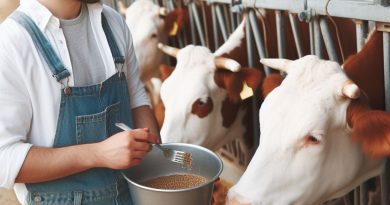Vertical Farming: Future of Urban Agriculture
Last Updated on February 2, 2024
Introduction
Vertical farming is an innovative agricultural technique that involves growing crops in vertically stacked layers, often in urban areas.
This method utilizes indoor spaces such as warehouses or high-rise buildings, allowing for efficient use of land and maximizing crop production.
With the global population projected to reach 9.8 billion by 2050, vertical farming is seen as a potential solution to meet the growing demand for food.
Urban agriculture, which includes vertical farming, is essential in addressing food security challenges in urban areas.
By bringing food production closer to consumers, it reduces the reliance on distant rural farms and minimizes transportation costs.
Additionally, vertical farming conserves water and reduces the need for pesticides, contributing to the overall sustainability of the agricultural system.
The importance of vertical farming extends beyond its direct impact on food security.
By utilizing vertical spaces, urban agriculture can transform abandoned buildings into productive and green spaces, improving the aesthetics of urban landscapes.
It also promotes community involvement and education, as individuals and organizations can actively participate in the cultivation of their own food.
In short, vertical farming offers a promising future for urban agriculture.
Its efficient use of space, reduced environmental impact, and potential for year-round production prove it to be a sustainable solution in addressing food security challenges.
As urban areas continue to expand, the integration of vertical farming is crucial to ensure a resilient and sustainable food system.
Why vertical farming is the future of urban agriculture
Utilization of limited space in urban areas
The future of urban agriculture rests on the success of vertical farming.
With limited space available in urban areas, traditional farming methods are no longer feasible.
Vertical farming offers a solution by utilizing both horizontal and vertical space, making the most efficient use of the limited area.
Year-round crop production
Furthermore, vertical farming allows for year-round crop production, overcoming the limitations of seasonal changes.
By cultivating crops indoors, farmers can control the climate, ensuring optimal conditions for growth.
LED lights provide the necessary light spectrum, allowing plants to photosynthesize and thrive regardless of natural daylight availability.
Reduction of environmental impact
Another significant advantage of vertical farming is its reduced environmental impact. By eliminating the need for extensive land use, natural habitats can be preserved.
Additionally, growing produce locally reduces the carbon emissions associated with long-distance transportation.
Vertical farming also minimizes water usage with innovative irrigation systems, contributing to sustainability.
Increased efficiency and yield
Vertical farming systems are designed for increased efficiency and yield.
Advanced technologies enable precise control of environmental factors, such as temperature, humidity, and nutrient levels.
This optimization allows plants to reach their full growth potential, maximizing crop yield.
Automation and robotics further enhance efficiency, streamlining processes and ensuring consistent production.
In fact, vertical farming offers a promising future for urban agriculture.
Its ability to utilize limited space, provide year-round crop production, reduce environmental impact, and increase efficiency and yield make it an ideal solution for sustainable urban farming.
As the world continues to face challenges related to food security and environmental sustainability, vertical farming presents a viable and innovative approach to address these issues.
Read: Rooftop Gardens: Sky-High Green Spaces
Advantages of vertical farming
Vertical farming, as a revolutionary concept in urban agriculture, offers numerous advantages that make it a promising solution for sustainable food production.
Minimizing water usage through recirculating systems
One of the key advantages of vertical farming is its ability to minimize water usage through the implementation of recirculating systems.
Unlike traditional agricultural practices, which require vast amounts of water for irrigation, vertical farms use advanced techniques to recycle and reuse water efficiently.
By utilizing hydroponic or aeroponic systems, plants are provided with the exact amount of water they need, reducing wastage.
Excess water is collected, filtered, and recirculated, significantly reducing overall water consumption.
This sustainable approach conserves this precious resource and alleviates the strain on freshwater reserves.
Elimination of pesticides and herbicides
Vertical farming also eliminates the need for harmful pesticides and herbicides, offering a healthier and safer way to cultivate crops.
In a controlled indoor environment, pests and diseases can be effectively managed without resorting to chemical interventions.
Through the implementation of integrated pest management strategies, such as biological controls and beneficial insects, natural predators can be introduced to combat pests.
This approach reduces the reliance on synthetic chemicals, ensuring that the produce grown in vertical farms is free from harmful residues and toxins.
Efficient energy usage with LED lights
Vertical farms make use of efficient energy technologies, particularly LED lights, to provide the necessary light spectrum for plant growth.
LED lights consume significantly less energy compared to traditional lighting systems, such as fluorescent or incandescent bulbs.
LED lights can be tailored to emit specific wavelengths of light, optimizing photosynthesis and plant growth.
They also produce less heat, reducing the need for additional cooling systems.
This energy-efficient approach enables vertical farms to operate year-round, regardless of external climate conditions, while minimizing energy consumption and greenhouse gas emissions.
Mitigation of transportation and contamination risks
Vertical farming offers the advantage of local food production, mitigating the risks associated with long-distance transportation.
With vertical farms located within or near urban areas, produce can be harvested and delivered to consumers within a short time span, ensuring maximum freshness and nutritional value.
This proximity not only reduces transportation costs but also decreases the carbon footprint associated with food distribution.
Additionally, vertical farms’ controlled environments minimize contamination risks throughout the production process, ensuring a safer and more hygienic food supply.
In essence, vertical farming presents numerous advantages that are crucial for the future of urban agriculture.
By minimizing water usage, eliminating pesticides, optimizing energy usage, and mitigating transportation and contamination risks, this innovative farming methodology demonstrates its potential as a sustainable solution for feeding our growing urban populations.
Read: Urban Farming 101: Getting Started with Basics
Types of crops suitable for vertical farming
Leafy greens and herbs
Vertical farming is particularly well-suited for growing leafy greens like lettuce, spinach, and kale, as they require minimal space and can be easily stacked one above the other.
These crops also have a shorter growing cycle, allowing for multiple harvests in a year.
Strawberries and other small fruits
Vertical farming systems provide an ideal environment for growing small fruits such as strawberries, which can be grown in specially designed vertical towers.
This method maximizes the use of space and enables easy access for pollination and harvesting.
Microgreens and sprouts
Microgreens and sprouts are gaining popularity in the culinary world due to their intense flavors and nutritional benefits.
Vertical farming allows for efficient and controlled growth of these delicate crops, making it easier to meet consumer demand.
Potential for experimenting with new crops
One of the intriguing aspects of vertical farming is its potential for experimenting with the growth of new and unconventional crops.
The controlled environment provides an opportunity to explore the cultivation of exotic plants, medicinal herbs, and even rare species.
Vertical farming opens up possibilities for sustainable urban agriculture by utilizing less land and reducing transportation costs.
The ability to grow crops close to consumers reduces the need for long-distance transportation, resulting in fresher and more nutritious produce.
Moreover, vertical farming incorporates advanced technologies like hydroponics and aeroponics, which optimize water and nutrient usage, minimizing waste.
These systems also eliminate the need for chemical pesticides and herbicides, promoting healthier and more organic produce.
The precise control of temperature, humidity, and lighting in vertical farms ensures optimal growing conditions throughout the year, overcoming seasonal limitations.
Leafy greens and herbs
Leafy greens and herbs are excellent choices for vertical farming due to their fast-growing nature and high demand in urban areas.
They provide a continuous harvest cycle, allowing farmers to meet market demands consistently.
Similarly, small fruits like strawberries thrive in vertical farming setups, utilizing vertical space efficiently and producing high yields.
Strawberries and other small fruits
Strawberries grown in vertical farms are often sweeter and more flavorful, as they receive proper nutrients and are picked at peak ripeness.
Microgreens and sprouts
Moreover, microgreens and sprouts, which are increasingly popular among health-conscious consumers, can be grown in vertical farms without the risk of contamination.
The controlled and sterile environment ensures safe and high-quality produce, making them an ideal choice for urban agriculture.
Potential for experimenting with new crops
Vertical farming also enables growers to experiment with new crops that are not traditionally grown in their region.
This fosters innovation and encourages the cultivation of diversified crops, providing consumers access to a wider range of fresh and unique produce.
The potential for vertical farming to support sustainable agriculture and food security is enormous.
By growing crops indoors, it becomes possible to feed a growing population without putting additional strain on limited arable land.
Vertical farming can also minimize the impact of climate change on food production by reducing the reliance on traditional farming methods.
In general, vertical farming offers a promising solution for the future of urban agriculture.
It allows for the cultivation of various crops, including leafy greens, small fruits, microgreens, and even new experimental species.
The controlled environment and advanced technologies employed in vertical farms ensure high-quality produce, reduced environmental impact, and increased food security.
As our cities continue to grow, vertical farming can play a crucial role in providing fresh and nutritious food to urban populations.
Read: Permaculture for Climate Change Adaptation
Technological advancements in vertical farming
Automated systems for planting, harvesting, and monitoring
The future of urban agriculture lies in the advancements of vertical farming techniques.
One key technological development is the use of automated systems for planting, harvesting, and monitoring crops.
These automated systems eliminate the need for manual labor, allowing for increased efficiency and productivity.
With the use of robotics, planting can be done quickly and accurately, ensuring precise spacing between crops.
Similarly, harvesting becomes a streamlined process, with robots identifying ripe crops and precisely cutting them for optimal yield.
This results in reduced waste and higher-quality produce.
In addition to planting and harvesting, automated monitoring systems play a critical role in vertical farming.
Sensors are integrated into the infrastructure, continuously collecting data on temperature, humidity, light levels, and nutrient levels.
This real-time data is then analyzed to ensure optimal growing conditions and to identify any potential issues.
By monitoring these parameters, farmers can make informed decisions to optimize crop growth, resulting in higher yields and healthier plants.
Integration of artificial intelligence and data analytics
Another technological advancement in vertical farming is the integration of artificial intelligence (AI) and data analytics.
AI algorithms are used to analyze the vast amounts of data collected from sensors and automated systems. These algorithms can identify patterns, optimize growing conditions, and even predict crop yields.
Data analytics further enhance the decision-making process in vertical farming.
By analyzing historical data and trends, farmers can gain insights into the most effective cultivation techniques and make data-driven decisions.
This integration of AI and data analytics not only improves productivity and efficiency but also contributes to sustainability.
By optimizing resource usage and crop growth, vertical farming reduces environmental impact and conserves resources.
Development of vertical farming infrastructure
Lastly, the continuous development of vertical farming infrastructure has been a crucial technological advancement in urban agriculture.
Vertical farming infrastructure includes facilities such as vertical towers, indoor farms, and rooftop gardens.
These structures are designed to maximize space utilization and provide optimal growing conditions.
In recent years, there has been an increased focus on developing scalable and modular infrastructure, allowing for easy replication and expansion.
This flexibility enables vertical farms to adapt to different urban environments with varying size constraints.
The development of climate-controlled environments is another aspect of vertical farming infrastructure.
By controlling factors such as temperature, humidity, and light intensity, farmers can create ideal growing conditions, irrespective of external weather conditions.
Furthermore, the vertical farming infrastructure incorporates advanced lighting systems like LED lights.
These lights provide specific wavelengths of light to promote photosynthesis and plant growth, resulting in higher yields and faster growth cycles.
In brief, technological advancements play a crucial role in the future of urban agriculture through vertical farming.
Automated systems, integration of AI and data analytics, and the development of vertical farming infrastructure contribute to increased productivity, sustainability, and resource efficiency.
Read: Edible Forest Gardens: Permaculture Gem

Challenges and Limitations of Vertical Farming
High Initial Costs and Maintenance Expenses
- Vertical farming requires significant upfront investment in infrastructure and equipment.
- The cost of constructing a vertical farm with advanced technology can be expensive.
- Regular maintenance of equipment, lighting, and irrigation systems adds to the overall expenses.
- High operational costs, including electricity bills and labor, can be a major challenge for vertical farming.
Energy Consumption and Reliance on Electricity
- Vertical farming heavily relies on artificial lighting and climate control systems, leading to increased energy consumption.
- The energy-intensive nature of vertical farms can strain the existing power grid in urban areas.
- Dependence on electricity makes vertical farming vulnerable to power outages and energy price fluctuations.
- Finding sustainable and efficient energy sources becomes crucial for the future viability of vertical farming.
Limited Crop Variety and Size Restrictions
- Certain crops, such as tall trees or plants with extensive root systems, are not suitable for vertical farming.
- Lack of space and height limitations may hinder the cultivation of large or sprawling crops.
- Vertical farms are better suited for leafy greens, herbs, and some fruiting crops, limiting the diversity of produce.
- Expanding the range of crops and optimizing plant growth in vertical farming remains a challenge.
Need for Proper Education and Training
- Vertical farming requires specialized knowledge and skills that are not commonly taught in traditional agricultural education.
- Farmers need training in managing soil-less systems, hydroponics, aeroponics, and climate control technologies.
- Understanding the intricacies of vertical farming, such as nutrient management and pest control, is crucial for success.
- Educating the workforce and providing accessible training programs can address the shortage of skilled vertical farmers.
Vertical farming has immense potential in revolutionizing urban agriculture, but it also faces several challenges and limitations.
High Initial Costs and Maintenance Expenses
The high initial costs and ongoing maintenance expenses pose financial obstacles for individuals or organizations interested in starting vertical farms.
Energy Consumption and Reliance on Electricity
Additionally, the energy consumption required to operate climate control systems and artificial lighting is a significant concern, given the existing strain on urban power grids and potential power outages.
Limited Crop Variety and Size Restrictions
Another limitation of vertical farming is the limited crop variety and size restrictions.
While leafy greens, herbs, and some fruiting crops can thrive in vertical farms, certain crops like tall trees or plants with extensive root systems are not suitable.
The ability to cultivate a diverse range of crops is essential for providing consumers with a wide variety of produce and creating a sustainable food system.
Need for Proper Education and Training
Moreover, the success of vertical farming depends on the availability of a skilled workforce. As vertical farming requires specialized knowledge and skills, proper education and training are crucial.
Farmers need to learn about soil-less systems, hydroponics, aeroponics, and climate control technologies to effectively manage their operations.
By providing accessible training programs and incorporating vertical farming into agricultural education, the industry can overcome the shortage of skilled professionals.
In review, while vertical farming offers numerous benefits for urban agriculture, it also faces challenges and limitations that need to be addressed.
Overcoming the high costs, reducing energy consumption, expanding crop variety, and providing proper education and training are significant steps toward realizing the full potential of vertical farming.
With continuous innovation and advancements, vertical farming has the potential to shape the future of urban agriculture and contribute to a more sustainable and resilient food system.
Success stories and examples of vertical farming around the world
AeroFarms in Newark, New Jersey
AeroFarms is an innovative vertical farming company based in Newark, New Jersey.
They have developed a system that allows them to grow crops indoors, using a fraction of the water and space required by traditional agriculture.
They have successfully grown a wide variety of leafy greens, herbs, and microgreens.
Sky Greens in Singapore
Sky Greens is a vertical farming project located in Singapore. They have created a vertical farming system that uses rotating towers to grow vegetables.
This unique method allows them to maximize sunlight exposure while minimizing the amount of land needed.
Sky Greens has been highly successful in producing vegetables for local consumption.
Plantagon in Sweden
Plantagon is a renowned vertical farming company based in Sweden.
They have developed a unique concept called the “Plantagon greenhouse” that combines traditional greenhouse farming with vertical farming techniques.
The greenhouse is designed to maximize efficiency and sustainability by recycling water and using renewable energy sources.
Plantagon has received global recognition for their innovative approach to urban agriculture.
Other notable urban farming projects globally
There are several other notable urban farming projects around the world that have achieved great success.
One such example is Gotham Greens, a company based in New York City, which operates rooftop greenhouses to grow fresh produce year-round.
Another example is Square Roots, a vertical farming startup in Brooklyn, New York, that focuses on growing herbs and leafy greens in hydroponic shipping containers.
These examples demonstrate the growing popularity and viability of vertical farming in urban areas.
Vertical farming has gained significant momentum in recent years, with several success stories and examples from around the world.
Companies like AeroFarms, Sky Greens, and Plantagon have demonstrated that vertical farming can be a sustainable and efficient solution for urban agriculture.
Their innovative approaches have not only increased crop yields but also reduced water usage and land requirements.
Furthermore, these success stories have inspired other urban farming projects globally.
Gotham Greens and Square Roots are just a few examples of the growing number of startups and initiatives that aim to bring fresh and locally grown produce to urban areas.
These projects are changing the way we think about agriculture and food production in cities.
Advantages vertical farming offers over traditional agriculture
Vertical farming offers numerous advantages over traditional agriculture.
By utilizing unused urban spaces and implementing advanced technologies, these projects are able to grow crops using less water and land while maximizing yields.
They also reduce the need for long-distance transportation, leading to fresher and more environmentally friendly produce.
Additionally, vertical farming allows for year-round cultivation, reducing dependence on seasonal harvests.
As the world continues to grapple with challenges such as population growth, climate change, and limited agricultural land, vertical farming provides a promising solution for sustainable food production in urban areas.
The success stories and examples mentioned above serve as inspiring models for others to follow.
In a nutshell, vertical farming has proven to be the future of urban agriculture.
With success stories like AeroFarms, Sky Greens, Plantagon, and other notable projects globally, it is evident that vertical farming is a viable and efficient method of growing crops in urban environments.
As more cities embrace this innovative approach, we can expect to see a significant shift towards sustainable and locally grown food.
Conclusion
Vertical farming provides a solution to the increasing challenges of traditional agriculture, such as limited land availability and climate change.
By utilizing vertical space, we can maximize crop yield and reduce the need for large plots of land.
This method also allows for year-round cultivation, eliminating the dependency on seasonal factors.
Additionally, vertical farming promotes efficient resource utilization. Through advanced technologies like hydroponics and aeroponics, we can optimize water and nutrient usage.
This not only conserves resources but also minimizes the impact of agriculture on the environment.
Furthermore, vertical farming brings agriculture closer to urban areas, reducing the distance between production and consumption.
This enables us to create local, sustainable food systems that decrease reliance on long-distance transportation.
Consequently, it decreases carbon emissions and enhances the freshness and nutritional value of produce.
To fully realize the potential of vertical farming, it is crucial for individuals, communities, and governments to embrace this innovative approach.
By supporting and investing in urban agriculture initiatives, we can cultivate a greener, healthier, and more resilient future.
Vertical farming presents a promising solution to the challenges faced by traditional agriculture.
It offers a multitude of benefits, including increased crop yield, efficient resource utilization, and localized food production.
To secure a sustainable future, we must actively encourage and support the implementation of vertical farming systems in our urban areas.
Let us rally behind this movement and invest in initiatives that promote urban agriculture for a healthier and more sustainable planet.


